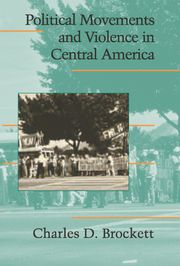Book contents
- Frontmatter
- Contents
- Figures, Tables, and Maps
- Abbreviations and Acronyms
- Acknowledgments
- 1 INTRODUCTION
- Part One From Grievances to Contentious Movements
- 2 THE SOCIAL CONSTRUCTION OF GRIEVANCES
- 3 THE EMERGENCE OF URBAN CONTENTIOUS MOVEMENTS: EL SALVADOR
- 4 THE EMERGENCE OF URBAN CONTENTIOUS MOVEMENTS: GUATEMALA
- 5 CONTENTIOUS PEASANTS AND THE PROBLEM OF CONSCIOUSNESS RAISING
- Part Two Opportunity, Contention, and Repression
- References
- Index
5 - CONTENTIOUS PEASANTS AND THE PROBLEM OF CONSCIOUSNESS RAISING
Published online by Cambridge University Press: 23 November 2009
- Frontmatter
- Contents
- Figures, Tables, and Maps
- Abbreviations and Acronyms
- Acknowledgments
- 1 INTRODUCTION
- Part One From Grievances to Contentious Movements
- 2 THE SOCIAL CONSTRUCTION OF GRIEVANCES
- 3 THE EMERGENCE OF URBAN CONTENTIOUS MOVEMENTS: EL SALVADOR
- 4 THE EMERGENCE OF URBAN CONTENTIOUS MOVEMENTS: GUATEMALA
- 5 CONTENTIOUS PEASANTS AND THE PROBLEM OF CONSCIOUSNESS RAISING
- Part Two Opportunity, Contention, and Repression
- References
- Index
Summary
Given the harsh economic conditions of everyday life, domination by local elites, and memories of past repression (most terribly, the massacre of somewhere between eight and thirty thousand largely rural people in El Salvador in 1932), peasant mobilization in Central America has needed the assistance of outside allies and support groups. Coming first in small numbers, over the years more and more religious workers, union organizers, urban students, political party activists, international development workers, and revolutionary guerrillas turned their attention to the peasantry and by the last half of the 1970s had catalyzed substantial change in many rural areas. From a once politically passive peasantry, throughout the region increasing numbers were joining peasant organizations and then multisector contentious movements, asserting their demands to local elites and then to national political leaders.
The importance of allies and support groups to the mobilization of people lacking political power is well established by case studies situated in the United States, such as those of farm workers (Jenkins and Perrow 1977; Jenkins 1985), miners (Billings 1990), and the civil rights movement (McAdam 1982). The importance of such groups to peasant mobilization also is one of the significant contributions of scholars writing from a political economy perspective. Activists from outside of peasant communities provide organizational expertise, moral support, and counterhegemonic ideologies and identities that help to build and strengthen ties of solidarity among subordinate groups.
- Type
- Chapter
- Information
- Political Movements and Violence in Central America , pp. 130 - 166Publisher: Cambridge University PressPrint publication year: 2005

